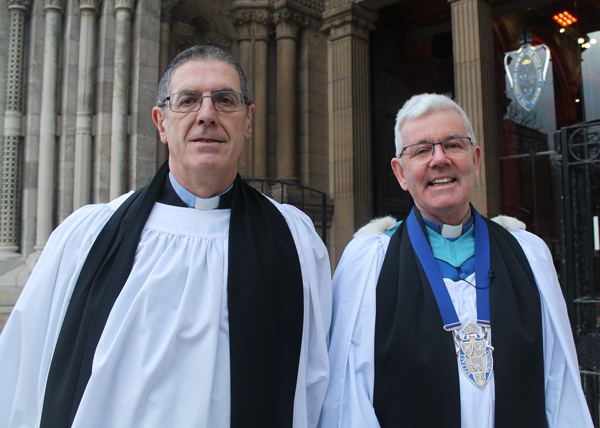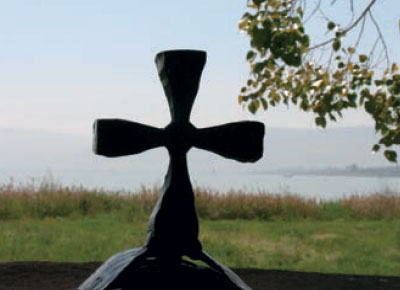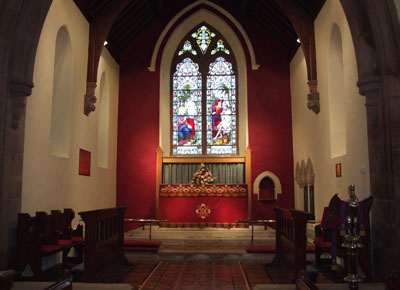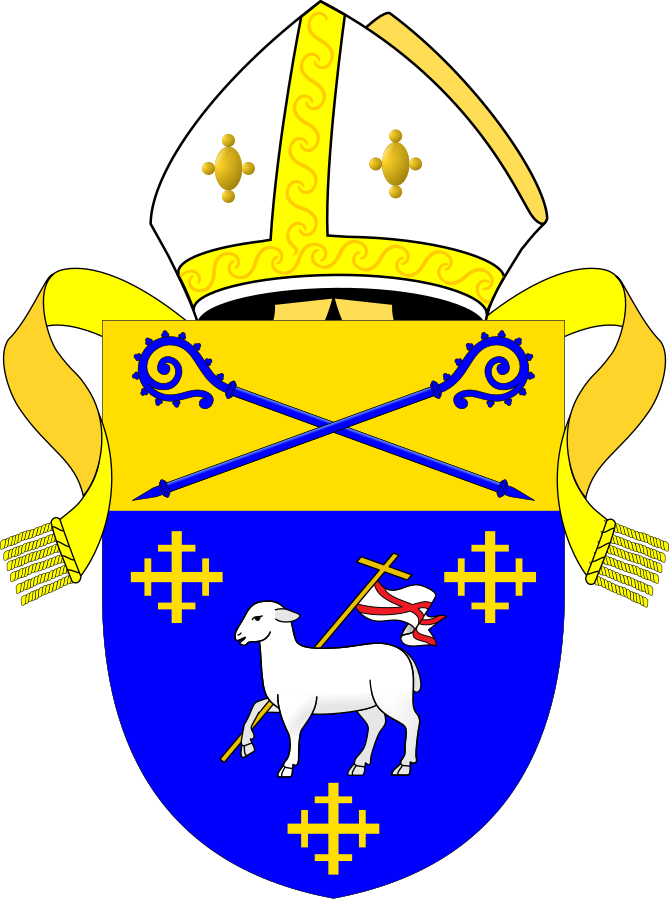Commemorating the tragedy of the MV Princess Victoria

The Rev Mark Reid, Mission to Seafarers Chaplain, and the Dean of Belfast, the Very Rev Stephen Forde, led the service to commemorate the 70th anniversary of the sinking of the MV Princess Victoria.
When the MV Princess Victoria sent out a distress call on January 31 1953, it was heard by a young tugboat crewman, who alerted his Master.
Within minutes, that tugboat was ready to go and assist in the rescue of the stricken ferry. But the Empire Meadow and its crew, including John Coulter who had picked up the distress call, was not permitted to leave Belfast Port.
“That ended the hopes of the Master and crew of the tug,” John recalls in a short note he penned about the event. “All were very upset about not being allowed to offer any assistance to the ship in distress.”

John Coulter, 95, heard the distress call from the MV Princess Victoria on that fateful day 70 years ago.
One hundred and thirty seven people perished in the stormy waters off the shores of Donaghadee that day. Each one was remembered as family, friends and the wider maritime community gathered in Belfast Cathedral on Sunday January 29 to commemorate the 70th anniversary of the loss of the Princess Victoria.
John was among them. Aged 95, he carried the Standard of the Merchant Navy at the opening of the service. His memories of the day still fresh, his knowledge of how it may have ended differently still raw.
The Princess Victoria, a roll-on roll-off ferry, sailed the crossing from Stranraer to Larne. She could hold 1,500 passengers as well as cars, lorries and cargo. There was sleeping accommodation for 54.
FLOUNDERED
Many of those lost to the sea when the ship floundered during a severe storm were residents of Belfast, along with the many crew members whose homes were in port towns of Larne and Stranraer in Scotland.
The dead included the Deputy Prime Minister of Northern Ireland, Maynard Sinclair, and the MP for North Down, Sir Walter Smiles. There were no women or children among the survivors.
The service at Belfast Cathedral was organised by the Rev Mark Reid, Belfast and Northern Ireland Chaplain to the Mission to Seafarers, with involvement from the Flying Angel Centre, the port authorities and the Harbour Commissioners.
The King’s Chorale choir lead the singing and Dean Stephen Forde, who was rector of Larne for 18 years, preached.
MEMORIAL
The service included an Act of Memorial during which 137 candles were lit by those in the congregation and by representatives of the Ports of Belfast and Larne, the Merchant Navy, the Mission to Seafarers and the RNLI. John was among those to light a candle.
During the Act of Memorial, Victoria, a unique musical elegy created by composer Ivan Black in tribute to the Princess Victoria, incorporating accordions, percussion, SOS messages and the melody of Eternal Father Strong to Save was played.
There were specially-written prayers for the bereaved and those affected by the loss of the Victoria; for rescue services, in particular the RNLI and search and rescue crews; for the shipping industry and for seafarers and those who minister to them.
The loss of the MV Princess Victoria remains the worst post-war loss of life in British coastal waters. Only 44 were rescued from the waters that night.
HEROICALLY
The service commemorated not only those who lost their lives, but those who fought heroically to try to save the Princess Victoria from floundering.
In his sermon, Dean Forde, who was rector in Larne for 18 years, spoke of personal connections with the disaster, and of some of these who had perished, including many of the crew of the Victoria’s sister ship, the Princess Margaret, which had been sailed to Holyhead for repairs and were travelling home from Stranraer to Larne on that early morning sailing.
“There were those who worked for Short and Harland at their aircraft factory at Wig Bay, near Stranraer. Each was returning home to Belfast on their regular two-week rotation,” the Dean said.
“Some had been visiting family, or were travelling to attend a funeral, or bringing home a new fiancée to meet the family. Others were travelling for business, and some were travelling to military postings across Northern Ireland.
“But each one of these individuals, the 44 crew members and passengers, who survived, and the 137 men, women and children who were lost, each was connected by planning or chance to be on board the Princess Victoria as she left the rail side pier in Stranraer and set sail into the relatively calm waters of Loch Ryan.”
RESONATE
And the Dean asked why is it that the events of that day still resonate so powerfully 70 years later?
“Perhaps it is because so many of us have made that same sea crossing ourselves. Perhaps it is because so many of those lost, left behind families and children, who remain our neighbours, and some of you may be present today. Perhaps it is because we all wonder to ourselves, ‘How would I react in such a situation and prepare to jump into the ice-cold sea?’”
He spoke of the respect those who live, work or travel by the sea have for the sea, and of the courage of those who answered the call to rescue.
“Today we also gather to acknowledge the courage of all those who on that day answered the call to rescue as many as they could,” the Dean said.
“We acknowledge the courage of Radio Operator, David Broadfoot, who stayed at his post to the end, to transmit the morse and radio signals which would finally locate the drifting ship, not off Corsewell Point in Scotland, but now 12 miles north north-east of the Copeland Islands.
SOS
“We remember the crew members who stood aside in their attempt to save the women and children. We acknowledge the courage of the Navy and merchant ships which braved the dangers of open waters to answer the SOS calls of distress. And we salute the heroism of the RNLI Lifeboat crews aboard the Jeanie Speirs, launched from Portpatrick in Scotland, and the Sir Samuel Kelly, launched from Donaghadee.
“On that dreadful day, so clearly remembered by so many, there were acts of courage and heroism which many of us can only wonder at.”
You can download Dean Forde’s full SERMON.
John Coulter, now living in Glengormley, joined the Empire Meadow as relief crew in September 1943 and was soon given a permanent post. In mid-1944, the tug was called to serve in the Normandy Landings, before returning to Belfast. As he was a month short in naval service time John did not go to Normandy, but at the recommendation of his Master, Robert John Mahood, he was transferred to the Wartime Merchant Navy Reserve Pool and joined a Merchant ship several months later.
EXPERIENCED
John brought a picture of the Empire Meadow and a photo of his Master to the Service in Belfast Cathedral. Robert John, he said, was an experienced captain and tug master, whose expertise as a tug master had been commended by the Queen of the Netherlands and the London Gazette.
“Whilst under naval control, Robert John was responsible for making all decisions, which he stood by and executed to the best of his ability,” John said. But when, in 1946, the ship was no longer required by the Ministry of War Transport, it was sold to a private company.
“On captain’s orders, when he heard the sad news of the disaster, he immediately got the tug ready for sea and this was completed in minutes.” But, John said, the tug’s owners did not permit it to be taken out.
Recalling that day, John added: “Our Tug Master said we may not be able to do anything, but my objective is let’s go and try to get a rope on board and tug it into the shelter of the lough.”
Unfortunately, the Empire Meadow and its crew did not have opportunity to even try.
After leaving the Merchant Navy, John worked for the Harbour Police for 30 years, and after retirement in 1982, ran his own tug boat until he reached the age of 86.
© Copyright The Church of Ireland Diocese of Connor 2024 | Web Design by LD2.digital
























